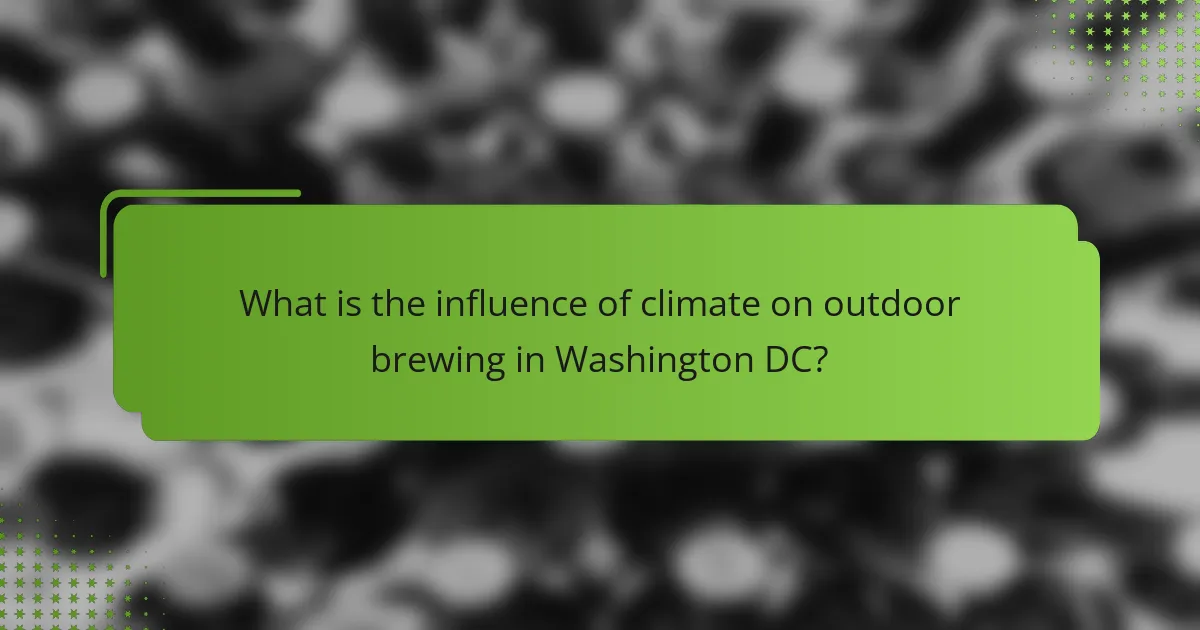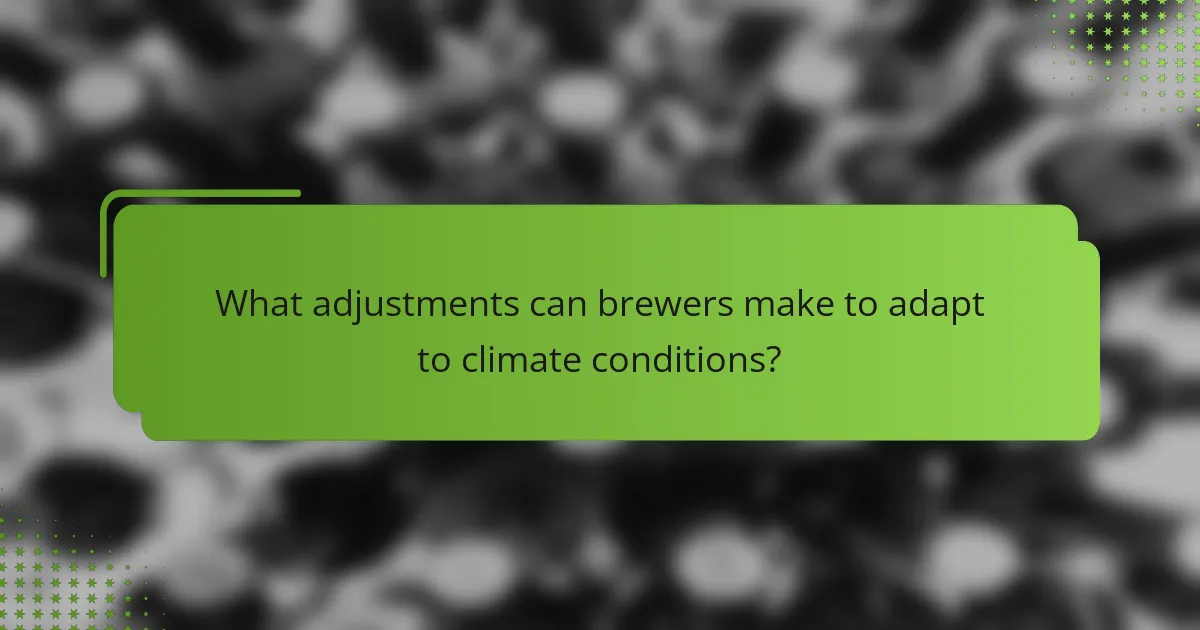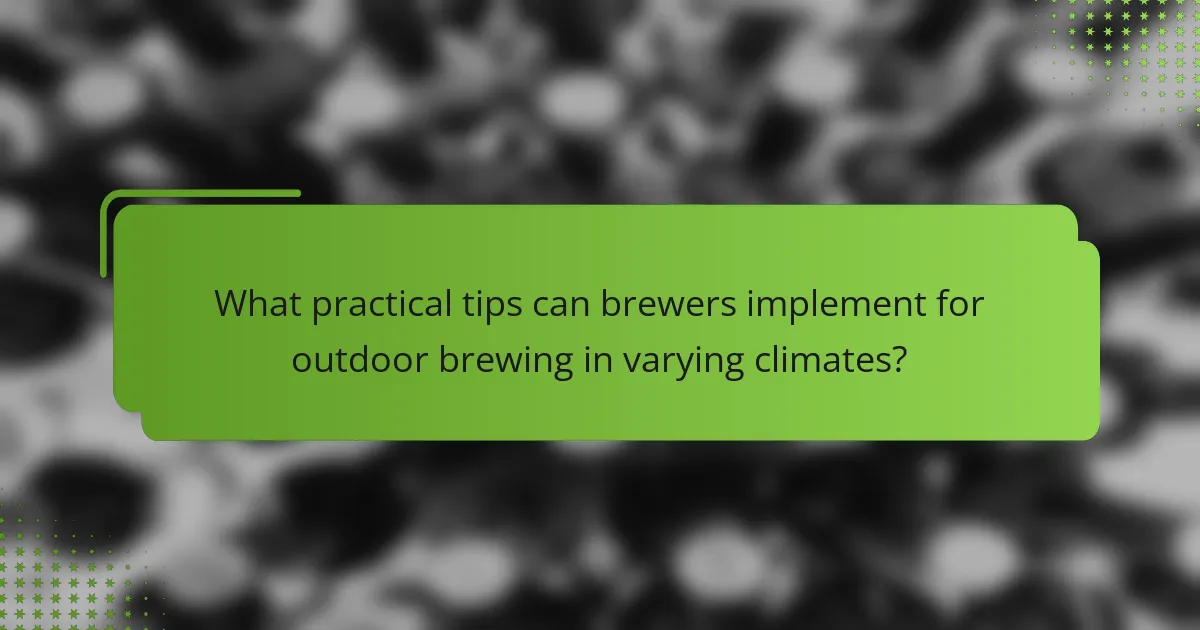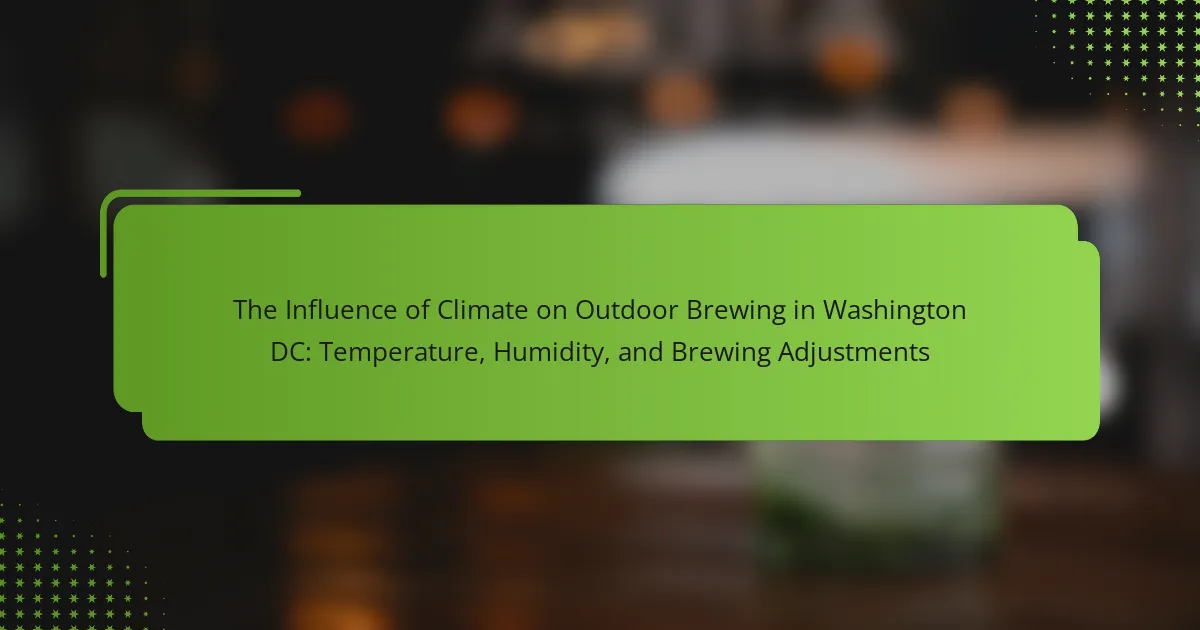Climate significantly influences outdoor brewing in Washington DC, characterized by a humid subtropical climate with hot summers and mild winters. High temperatures can accelerate fermentation, while cooler conditions may slow it down, and humidity affects evaporation rates during brewing. Brewers must adapt their processes, including timing, fermentation temperatures, and ingredient sourcing, to maintain quality and efficiency. Practical tips for outdoor brewing include monitoring temperature, using insulated containers, and selecting appropriate yeast strains based on climate conditions. Additionally, implementing water conservation techniques and maintaining a brewing journal can enhance the brewing process and outcomes.

What is the influence of climate on outdoor brewing in Washington DC?
Climate significantly influences outdoor brewing in Washington DC. The city experiences a humid subtropical climate. This results in hot summers and mild winters. High temperatures can accelerate fermentation processes. Conversely, cooler temperatures may slow them down. Humidity levels impact the evaporation rate during brewing. Higher humidity can lead to less evaporation, affecting the final product. Seasonal variations also require brewers to adjust recipes. For example, summer brews may focus on lighter styles. Winter brews often emphasize richer, darker flavors. These climate factors necessitate careful planning for successful outdoor brewing.
How do temperature and humidity specifically affect the brewing process?
Temperature and humidity significantly impact the brewing process. Higher temperatures can accelerate fermentation, leading to a quicker production of alcohol and flavors. However, excessive heat may also produce off-flavors and affect yeast health. Conversely, lower temperatures slow fermentation, resulting in a cleaner taste but longer brewing times.
Humidity affects the moisture content in the air, which can influence hop utilization and the evaporation of volatile compounds. High humidity can lead to slower evaporation rates during boiling, potentially altering the final flavor profile. Additionally, humidity can impact the stability of ingredients, such as malt and hops, affecting their quality over time.
Research indicates that optimal brewing temperatures typically range from 60°F to 75°F, depending on the beer style. A study published in the Journal of the American Society of Brewing Chemists highlights that yeast activity peaks at specific temperature ranges. Understanding these factors allows brewers to make necessary adjustments to achieve desired flavor outcomes.
What temperature ranges are optimal for brewing different types of beer?
The optimal temperature ranges for brewing different types of beer vary significantly. For lagers, the ideal fermentation temperature is between 45°F to 55°F (7°C to 13°C). Ales, on the other hand, thrive at warmer temperatures, typically between 60°F to 75°F (15°C to 24°C). Wheat beers often prefer a range of 60°F to 70°F (15°C to 21°C) for fermentation. Stouts and porters can ferment well at temperatures from 65°F to 70°F (18°C to 21°C). These temperature ranges are crucial because they influence yeast activity and flavor development. Proper temperature control ensures optimal fermentation and affects the final taste profile of the beer.
How does high humidity impact the brewing ingredients and final product?
High humidity affects brewing ingredients and the final product by altering moisture levels in grains and hops. Increased moisture can lead to mold growth on grains, compromising quality. High humidity can also affect hop utilization during boiling, resulting in less efficient extraction of bitterness and aroma. Additionally, yeast fermentation may be impacted, as humidity influences temperature and pressure conditions. This can lead to off-flavors in the final product. According to the Brewers Association, maintaining optimal humidity levels is crucial for consistent brewing results.
Why is understanding climate variability important for brewers in Washington DC?
Understanding climate variability is crucial for brewers in Washington DC because it affects ingredient quality and brewing processes. Variability in temperature and humidity can influence fermentation rates and flavor profiles. For instance, higher temperatures may lead to faster fermentation, potentially altering the final product’s taste. Additionally, fluctuations in humidity can impact the moisture content of grains, affecting mash efficiency. Historical data shows that brewers who adapt to climate changes can maintain consistency in their beer quality. This adaptability is essential for meeting consumer expectations and ensuring product reliability.
What seasonal changes should brewers anticipate in Washington DC?
Brewers in Washington DC should anticipate significant seasonal changes that affect brewing conditions. In spring, temperatures rise, leading to increased yeast activity. Humidity levels also begin to rise, which can impact fermentation. Summer brings high temperatures, often exceeding 90°F, requiring brewers to adjust cooling methods. Increased humidity can lead to challenges in maintaining consistent fermentation temperatures. Fall sees a decrease in temperatures, providing ideal brewing conditions with lower humidity. Winter brings cold temperatures, often below freezing, which may necessitate indoor brewing or heating solutions. These seasonal variations directly influence brewing schedules and techniques.
How do local climate patterns influence brewing schedules?
Local climate patterns significantly influence brewing schedules by affecting temperature and humidity levels. High temperatures can accelerate fermentation, requiring brewers to adjust timelines. Conversely, cooler temperatures may slow down yeast activity, extending brewing periods. Humidity levels also impact the evaporation rate during boiling, which can alter the concentration of flavors. For example, higher humidity may lead to less evaporation, resulting in a different final product. Seasonal variations in climate patterns dictate when certain ingredients are available, influencing brewing decisions. Therefore, brewers must adapt their schedules based on these local climate conditions to ensure optimal results.

What adjustments can brewers make to adapt to climate conditions?
Brewers can adjust their processes to adapt to climate conditions. They may alter the timing of brewing to avoid extreme temperatures. Adjusting the fermentation temperature is crucial for yeast activity. Brewers can also change ingredient sourcing based on climate impacts on crops. Implementing water conservation techniques helps manage resources effectively. Utilizing temperature-controlled environments ensures consistency in brewing. Adapting packaging methods can protect products from heat exposure. These adjustments are essential for maintaining quality and production efficiency.
How can brewers modify their techniques based on temperature fluctuations?
Brewers can modify their techniques by adjusting mash temperatures and fermentation schedules based on temperature fluctuations. Higher ambient temperatures may require lower mash temperatures to prevent over-extraction of sugars. Conversely, cooler temperatures can necessitate higher mash temperatures to ensure proper enzyme activity.
Brewers may also alter yeast pitching rates to account for temperature changes. Warmer temperatures can lead to faster fermentation, so a lower pitching rate can help control this process. In contrast, cooler temperatures may require a higher pitching rate to achieve desired fermentation speed.
Additionally, brewers might employ temperature-controlled fermentation vessels to maintain consistent conditions. This helps mitigate the effects of external temperature variations. Historical data shows that temperature management can significantly influence flavor profiles and overall beer quality.
What specific brewing methods are best suited for hot weather?
Cold brew and iced coffee are the best brewing methods for hot weather. Cold brew involves steeping coarsely ground coffee in cold water for 12 to 24 hours. This method produces a smooth, less acidic coffee that is refreshing in high temperatures. Iced coffee, on the other hand, is brewed hot and then cooled down quickly, typically over ice. This method retains the coffee’s flavor while providing a chilled beverage. Both methods are ideal for hot weather as they can be served cold, enhancing hydration and refreshment during warm days.
How should brewers alter their processes during cold spells?
Brewers should adjust their processes during cold spells by increasing fermentation temperatures. This helps yeast activity and improves fermentation efficiency. Additionally, brewers may consider using insulated fermentation vessels. Insulation helps maintain consistent temperatures despite external cold. They should also extend fermentation times to accommodate slower yeast activity. Monitoring gravity readings becomes crucial during this period. Adjusting hop additions may be necessary to enhance flavor profiles. Finally, brewers should ensure proper sanitation to avoid contamination risks. These adjustments are essential for maintaining product quality in colder conditions.
What role does humidity play in brewing adjustments?
Humidity affects brewing adjustments by influencing the moisture content in ingredients and the brewing environment. High humidity can lead to increased moisture in grains, which may affect extraction rates. This can result in a higher efficiency during mashing. Conversely, low humidity can dry out grains, potentially leading to lower extraction rates. Adjustments in water temperature and grain ratios may be necessary to compensate for these moisture variations. Studies indicate that brewers often need to modify their recipes based on local humidity levels to achieve desired flavor profiles.
How can brewers manage moisture levels during fermentation?
Brewers can manage moisture levels during fermentation by controlling the fermentation environment. They can use temperature regulation to minimize excess moisture. Maintaining optimal temperature ranges helps reduce condensation. Additionally, using ventilation systems allows for proper airflow. This airflow helps to remove excess humidity from the fermentation area. Brewers can also monitor and adjust humidity levels with hygrometers. Implementing these methods can lead to a more controlled fermentation process. Proper moisture management can enhance fermentation quality and consistency.
What are the best practices for storing ingredients in humid conditions?
Store ingredients in airtight containers to prevent moisture absorption. Use glass or heavy-duty plastic containers for optimal protection. Keep storage areas cool and dry, as humidity can promote spoilage. Use silica gel packets to absorb excess moisture in storage. Regularly check for mold or spoilage, especially in high-humidity environments. Label containers with dates to track freshness. Rotate stock to use older ingredients first. These practices help maintain ingredient quality and extend shelf life.

What practical tips can brewers implement for outdoor brewing in varying climates?
Brewers can implement several practical tips for outdoor brewing in varying climates. First, they should monitor temperature closely. Temperature affects fermentation and flavor profiles. In hot weather, brewers can use insulated containers to maintain cooler temperatures. Conversely, in cold climates, wrapping fermenters with heating pads can help maintain warmth.
Humidity levels also play a role. High humidity can slow evaporation rates. Brewers may need to adjust boil times accordingly. In dry conditions, they should ensure adequate hydration of ingredients.
Using shade structures can protect equipment from direct sunlight. This helps maintain stable temperatures during the brewing process. Additionally, brewers should consider windbreaks to prevent cooling from breezy conditions.
Choosing the right yeast strain is crucial. Some yeast varieties perform better in specific temperature ranges. Brewers should research yeast characteristics before selecting strains.
Lastly, keeping a brewing journal can help track conditions and outcomes. This practice allows brewers to refine their techniques based on previous experiences.
How can brewers prepare for unexpected weather changes?
Brewers can prepare for unexpected weather changes by implementing flexible brewing schedules and adjusting ingredient ratios. Monitoring weather forecasts allows brewers to anticipate changes in temperature and humidity. This proactive approach enables them to make necessary adjustments in real-time. For example, higher humidity may require alterations in grain moisture content. Additionally, brewers should maintain equipment that can adapt to varying conditions, such as temperature-controlled fermentation tanks. Historical data indicates that breweries with adaptive strategies experience fewer production disruptions. Therefore, preparedness is essential for maintaining quality and efficiency in brewing.
What tools and technologies can assist in climate monitoring for brewers?
Climate monitoring for brewers can be assisted by various tools and technologies. These include weather stations that track temperature and humidity levels. IoT sensors provide real-time data on environmental conditions. Mobile applications offer forecasts and alerts for weather changes. Remote monitoring systems allow brewers to access data from multiple locations. Data analytics software can analyze historical climate trends relevant to brewing. Climate modeling tools help predict future weather patterns affecting brewing processes. These technologies enhance decision-making for optimal brewing conditions.
What are the best practices for outdoor brewing setups in Washington DC?
The best practices for outdoor brewing setups in Washington DC include selecting a shaded area to avoid direct sunlight. This is crucial as high temperatures can affect fermentation. Use a portable brewing system that is easy to transport and set up. Ensure access to clean water for brewing and sanitation. Monitor humidity levels, as high humidity can impact the brewing process. Adjust your brewing schedule to early mornings or late evenings to avoid heat peaks. Utilize insulated containers to maintain temperature stability during brewing. Lastly, familiarize yourself with local regulations regarding outdoor brewing to ensure compliance.
The primary entity in this article is outdoor brewing in Washington DC, which is significantly influenced by the city’s humid subtropical climate. Key factors such as temperature and humidity impact fermentation processes, ingredient quality, and flavor profiles, necessitating adjustments in brewing techniques and schedules. The article outlines optimal temperature ranges for various beer styles, the effects of humidity on ingredients, and practical tips for brewers to adapt to seasonal changes and unexpected weather. Additionally, it discusses tools and technologies that assist in climate monitoring to enhance brewing efficiency and consistency.
